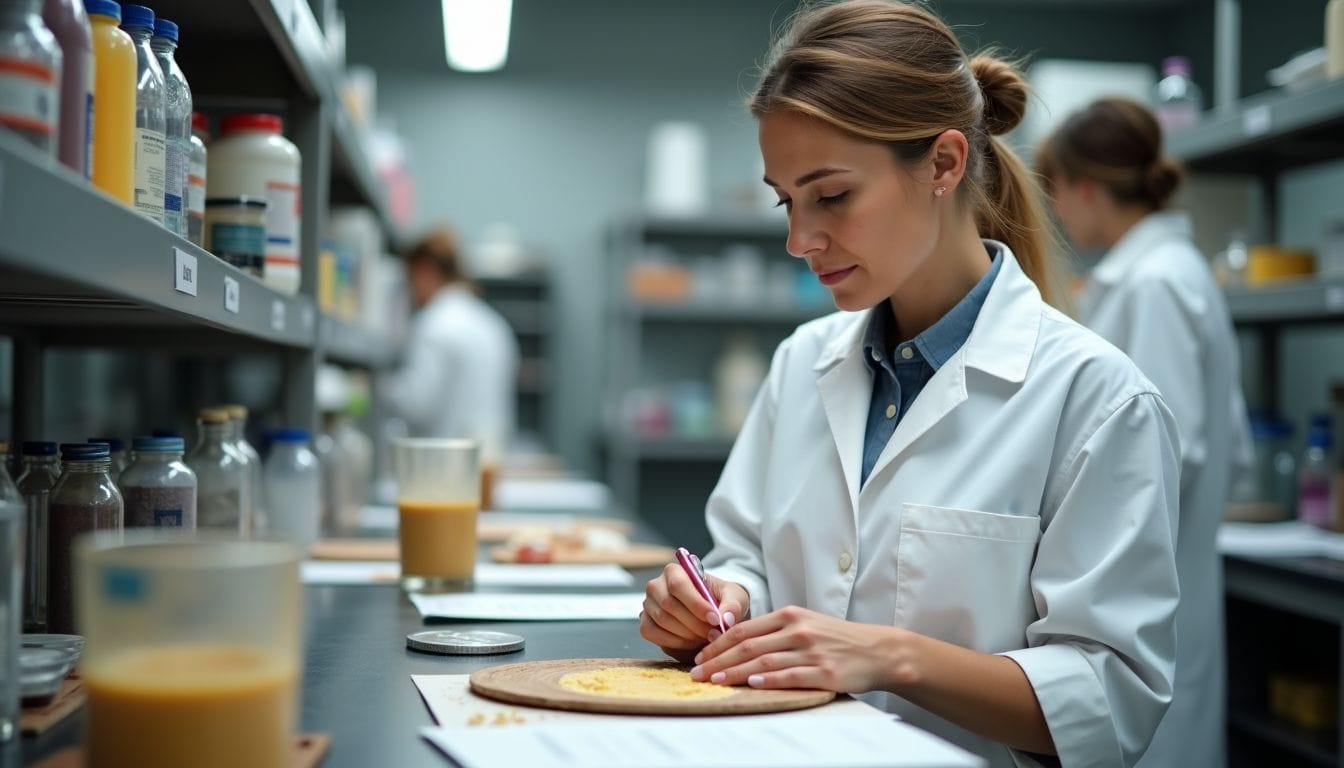R&D Tax Credits Food Industry
Are you struggling to fund innovation in your food business? You’re not alone. Many UK food companies miss out on R&D tax credits, leaving money on the table.
Did you know the food industry is the UK’s largest manufacturing sector? It’s true. This article will show you how to claim R&D tax credits for your food company. You’ll learn what qualifies and how to maximise your claim.
Ready to boost your innovation budget?
What Are R&D Tax Credits in the Food Industry?

R&D tax credits in the food industry are cash rewards for innovation. You can get money back for trying new things in your food business.
Definition and Purpose
Research and development tax credits give food companies a chance to save money on their taxes. These credits reward firms for trying new things in food and drink. You can get back 5% to 10% of what you spend on research each year.
Our government wants to help food firms grow and create new products. That’s why they give tax breaks for work on things like longer shelf life or better taste. You can use the money you save to do more research or hire more staff.
These credits cover costs like wages, supplies, and outside help for R&D work. If you’re a small firm, you might even use the credits to lower your payroll taxes. This helps you keep more cash in your company to fund future projects.
Eligibility Criteria for Food Companies
Food firms can get tax credits for new projects. You must meet certain rules to qualify.
- Your food company must pay UK tax
- You must spend money on special R&D work
- Projects should try to improve food science or tech
- Work must solve hard science or tech problems
- Tasks can include making new foods, ways to work, or services
- Making current foods or work methods better also counts
- Trying to make healthier foods with less added stuff qualifies
- Looking into food issues to make new products is okay
- Making food storage, cooking, or wrapping better can count
- Growing from small to big food-making is R&D
- You can get back up to 33% of extra tax you paid
How Can Food Companies Benefit from R&D Tax Credits?

R&D tax credits can boost your food company’s cash flow. You’ll get money back for your innovative projects, helping you grow faster.
Financial Advantages
Tax credits for research and development can give food firms big cash boosts. You might get back up to 33% of what you spend on new ideas. This money helps you invest in fresh projects and stay ahead.
It’s not just for large firms – small ones can gain too. The credits cover costs for staff, supplies, and some extras.
These tax breaks really help your profits. You can use the extra money to hire more people, buy new tools, or do more research. It’s like getting paid to try new things! Also, it’s easier to do than you might think.
With help from experts, you can quickly get this useful funding.
Innovation Incentives
R&D tax credits boost new ideas in the food world. You can cut project costs by up to 25% with these credits. This helps you try fresh ideas without spending too much.
Food firms often use R&D credits to make food last longer. You might make better ways to process food or create new packaging. These steps keep food fresh and reduce waste. Moving from small tests to big production also counts as R&D.
You can claim credits for growing your tasty ideas.
The UK wants to help food firms grow through R&D rewards. You can get help to make healthier foods or green packaging. Even small changes to recipes or how you make food can count.
Don’t miss this chance to fund your next big food idea.
What Types of Food Industry Projects Qualify for R&D Tax Credits?

R&D tax credits can boost your food business. They cover many projects, from new recipes to better packaging.
Product Development
Food firms can claim tax credits for making new products. This includes creating healthier foods, plant-based choices, and new ingredients. You could get back up to 18.6% of your costs through these credits.
Work on meat swaps or better nutrition often counts.
Green worries and what buyers want drive food research. Firms focus on eco-friendly packing and cleaner ways to make food. These efforts can lead to big tax savings. Your work on new tastes, textures, or ways to make food may earn credits.
Process Improvement
Process upgrades in food R&D can boost your tax credits. You can claim for work to make output more efficient or green. For example, making plastic-free wrapping counts as R&D. So does work to make food last longer.
These projects often cut costs and improve products.
Tax credits reward your clever ideas in food making. You have two years after you finish a project to ask for money back. But the rules can be hard to follow. It’s wise to get help from experts.
They can make sure you don’t miss out on any perks. With good advice, you can turn your process upgrades into big tax savings.
Packaging Innovation
Food firms can get tax credits for new packaging ideas. Making better food boxes and wraps can lead to these credits. This means using earth-friendly stuff and designs that keep food fresh longer.
Companies that spend money on green packaging might get some cash back.
What people want to eat changes how food is wrapped. Foods for vegans and people with allergies need special packs. This opens doors for tax help. Firms making clever packs with special codes or heat checkers can also gain.
The tax office sees this work as new and smart.
Tax credits help food makers create better wrapping. This keeps them strong in the market and makes buyers happy. Firms can claim for worker costs, materials, and some other spending.
To get the most back, keep good notes on all packing projects.
How Do R&D Tax Credits Impact Different Sectors of the Food Industry?

R&D tax credits boost growth across food sectors. They help farms, factories, and tech firms create better products and methods.
Agriculture and Farming
Farmers, you can make more money with tax credits for research. In 2022, UK farms got about £42,373 each on average. This cash helps you try new things and grow more food. The government wants to help you come up with fresh ideas.
They put £270 million into a special farm programme last year.
You might be using cool tech already. Robots and drones can help you work smarter. These tools can fix worker shortages and make your farm more productive. Don’t miss out on this chance to get money back for your hard work and new ideas.
Food Manufacturing
Food makers have many chances to get R&D tax credits. They can claim for new foods, longer shelf life, and better ways to make things. In 2022-23, UK firms made 16,030 R&D claims. These were worth £1,690 million.
On average, makers claimed £105,427. Dairy, bakery, drinks, and chemical firms can all get these credits.
R&D in food making aims to improve taste, health, and speed. You might try to cut sugar or add good stuff to food. Or you could make faster ways to make food. These efforts can save you lots of tax money.
They also keep your foods fresh and help you beat other firms.
Food Technology
Food tech is changing quickly. New plant-based meats and clever packaging are coming to shops. These new ideas help firms stay ahead in a growing market. The food and drink sector is growing by 7.3% each year.
This offers big chances for R&D claims.
Your food tech work might qualify for tax credits. Staff wages, materials, and some contractor costs count as valid expenses. Try to make food more green, efficient, or suited to new tastes.
These efforts often fit HMRC’s R&D rules.
R&D in food tech isn’t just for big companies. Small and medium food firms can gain too. You might be working on food that lasts longer or eco-friendly wrapping. Maybe you’re changing recipes to be healthier.
All these could be R&D tasks worth claiming for.
What Are the Common Challenges in Claiming R&D Tax Credits for Food Companies?

Food companies often struggle with paperwork and spotting R&D work… Want to know more about these hurdles?
Documentation Requirements
Good records are key for R&D tax credit claims. You need clear money facts and a full tech story. Keep track of all costs, staff time, and things you use. Your records must show how your work fits R&D rules.
Good notes help you avoid common mistakes, like missing early R&D work. Keep in mind, you have two years from when your books close to file claims. Strong proof helps your claim do well.
Identifying Qualifying Activities
Spotting R&D activities in food can be tricky. You need to look for projects that solve tech or science problems. These might include creating new recipes, improving food safety, or making packaging more eco-friendly.
Focus on work that pushes the limits of what’s known. Even if a project fails, it can still count if it tried to solve a real challenge. Keep an eye out for tasks that test new ideas or methods in your food business.
RD Tax Credits UK helps you find these hidden gems. We know the food industry inside out. Our team spots R&D in places you might miss. We’ve helped food firms claim millions in tax relief.
From small cafes to big factories, we find the R&D that counts. Our 98% success rate shows we know what HMRC looks for in claims.
How Can Food Companies Maximize Their R&D Tax Credit Claims?

Want to get the most from your R&D tax credits? Keep good records and team up with tax pros… Read on for more tips to boost your claims!
Best Practices for Record Keeping
Keep good records of your R&D work. Write down what you do, problems you face, and how long it takes. This helps you make a strong case for tax relief. The tax office likes to see clear proof of your work.
Have team talks often to chat about R&D progress. Use these talks to note what each person does. It’s a great way to track your work and back up your claims. It also keeps your whole team up to date.
Use computer tools to store your R&D records. This makes it easy to find info when you need it. You can quickly show data to the tax office if they ask. Good records help your claim go smoothly and succeed.
Collaboration with Tax Professionals
Team up with tax pros to boost your R&D claims. These experts know all about food industry tax credits. They’ll help you find all costs you can claim. They’ll make sure your claim follows HMRC rules.
With their help, you could get more money back for your food and drink projects.
Tax experts can guide you through the tricky world of R&D credits. They’ll show you how to keep good records. They’ll help you prove your work counts as R&D. This teamwork often leads to bigger claims.
It also means fewer hassles with HMRC. Plus, you’ll learn tips to make future claims easier and better.
What Recent Changes Affect R&D Tax Credits in the Food Industry?

Recent policy shifts have changed how food companies can claim R&D tax credits… Want to know more? Keep reading!
Policy Updates
R&D tax relief rules have changed. From 1 April 2023, small firms get less help. Their extra cut dropped from 130% to 86%. The credit rate fell from 14.5% to 10%. But there’s good news too.
RDEC relief went up from 13% to 20%.
Big changes are coming in April 2024. A new merged R&D scheme will start. It will have a set credit rate of 20%. This affects food and drink firms doing R&D. You’ll need to plan for these new rules.
They impact how much tax relief you can claim.
These updates aim to boost UK innovation. They focus on real R&D work. The food trade can still benefit. You might qualify if you’re making new products or fixing how things work. Things like green packaging or plant foods could count.
Keep good records to make the most of these credits.
Industry-Specific Considerations
Food firms face special challenges when claiming R&D tax relief. Strict food safety rules and changing tastes drive new ideas. You need to show how your projects meet these needs.
Your R&D might focus on new recipes, better packaging, or healthier ingredients. These efforts often qualify for tax credits. Keep good records of all your tests and trials. This helps prove your work to the tax office.
Many food companies miss out on R&D perks because they don’t know about them. Don’t let this happen to you. Look at how your daily work could lead to tax savings. Even small gains in taste or shelf life can count as R&D.
How Do R&D Tax Credits Compare to Other Incentives for Food Industry Innovation?

R&D tax credits offer more flexibility than grants for food companies. They let you claim back costs on failed projects too. Want to know more about how they stack up against other options? Read on!
Grants vs. Tax Credits
Grants and tax credits give food firms different perks. Grants offer cash up front but often have strict rules. Tax credits lower your tax bill after you spend on R&D. You can claim credits each year, which makes them more flexible.
Many food firms like tax credits better as they’re easier to get and use. They also reward ongoing new ideas, not just one-off projects.
UK food firms can mix grants and credits for the most gain. Grants help start big projects. Tax credits support long-term R&D work. This mix boosts new ideas and keeps firms strong.
It’s key to check rules, as some grants may change your tax credit claims. Smart use of both can help food firms grow.
International Comparisons
R&D tax credits differ across countries. The UK’s plan stands out because it doesn’t include research in arts, social studies, and human nature. This may not show the true value of R&D for the UK’s money matters.
Many countries give better R&D rewards than the UK. France offers a 30% tax break on the first €100 million spent on R&D. Ireland gives a 25% tax break on all R&D costs. These plans often cover more types of work, including arts and social studies.
Some nations focus on certain fields. Canada’s plan aims at tech firms. It gives back up to 35% of R&D costs to small businesses. This helps new ideas grow in fast-moving industries.
What Is the Future Outlook for R&D Tax Credits in the Food Industry?

The future of R&D tax credits in the food industry looks bright, with a focus on green tech and AI… Want to know more?
Emerging Trends
Food firms in the UK are using AI and machine learning to improve their research. These tools help make new recipes, guess what people will like, and make production better. Plant-based foods and green packaging are big trends.
Companies are working hard to make fake meat and eco-friendly wraps that people want.
Tax credits for research help pay for these new projects. They give money back to food firms that use new tech and methods. As people care more about health and the planet, expect more research into healthy foods and less waste.
These trends will shape how food firms create new things and claim tax credits in the future.
Potential Policy Changes
The 2024 UK General Election could shake up R&D tax credits for food firms. Labour wants to steady these credits and set up a new office to help with rules. From 1 April 2024, two R&D schemes will join into one for all firms.
This change affects how food companies claim tax credits. You need to plan ahead to handle these changes well. The new rules might change how much you can claim and what counts as R&D in food and drink.
UK food and drink firms must watch these policy shifts. They could affect your profits and how you make new things. Keep an eye on tax office updates about the new single scheme. It might change how you track R&D spending on things like new recipes or green packaging.
Smart planning now can help you get the most from future R&D tax perks.
Conclusion
R&D tax credits boost food industry innovation. You can claim for new products, processes, and packaging. Keep detailed records of your projects. Work with experts like RD Tax Credits UK to maximize your claims.
Act now to fuel your company’s growth and stay ahead in the market.

